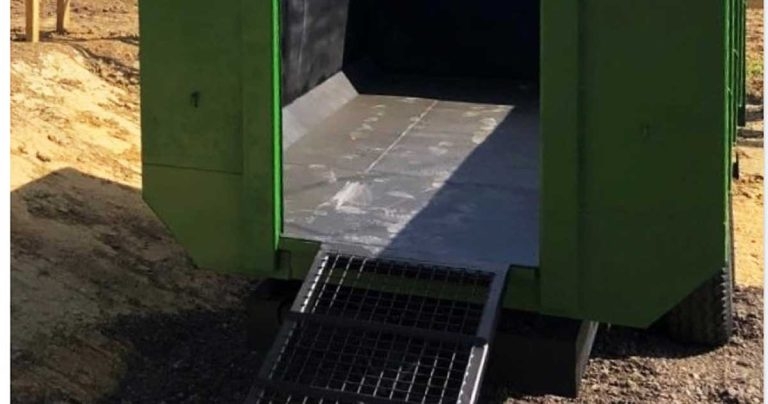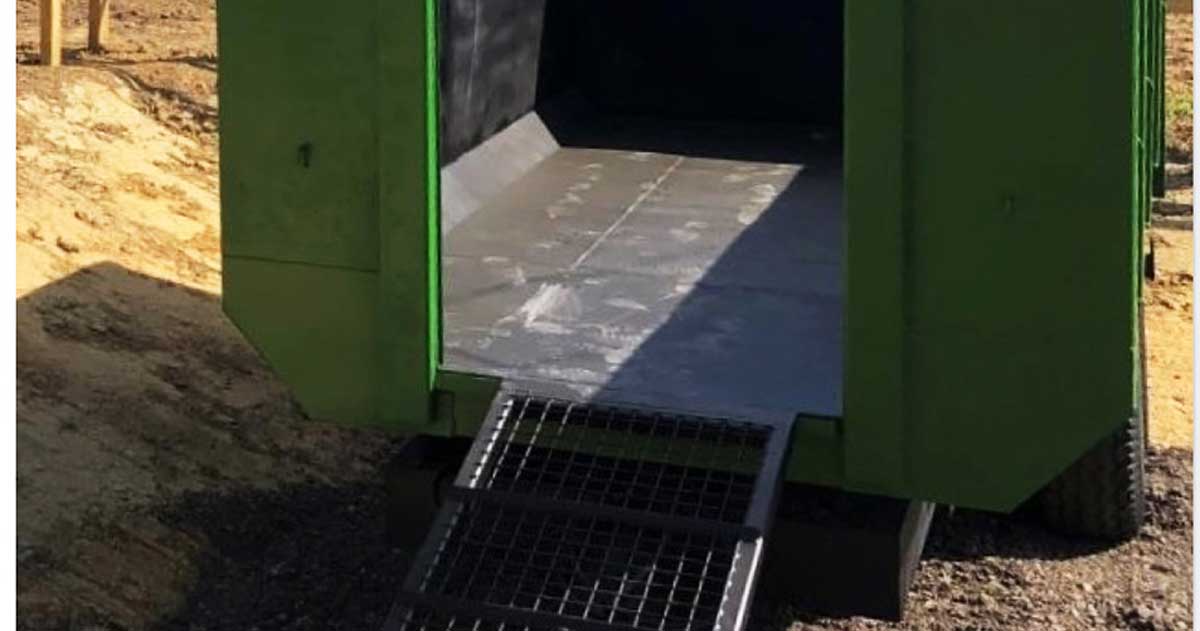2 Mar 2021
With three-quarters of horse owners wanting to know more about preventive health care, according to one survey, opportunities for vets to provide more information do exist. In this piece, Zoë Gratwick provides practical advice that can be passed on to horse owners on parasite prevention.

Figure 1. A high-sided trailer can help to contain a muck heap, minimising larval migration on to a pasture.
Ways the management of horses could be improved to reduce their risk of parasitic disease often exist.
An online study, conducted as part of the Keeping Britain’s Horses Healthy Campaign 2017, identified 76% of participating horse owners as “wanting to learn more about preventive health care”, potentially suggesting an opportunity for vets to discuss such management advice.
The risks will vary on different properties, affected by factors such as the age and health status of resident horses, paddock space, and movement on and off a property. The identification of risks and the implementation of often simple measures can reduce the likelihood of disease, and the requirement for anthelmintic administrations.
The most significant adult equine endoparasites in the UK are cyathostomins (small strongyles or small redworms), the tapeworm Anoplocephala perfoliata and large strongyles. Oxyuris equi, Habronema species, Dictyocaulus arnfieldi, Fasciola hepatica and some others are also worth consideration in certain circumstances. Ascarid and strongyle infections can be significant in young animals, and are discussed elsewhere1.
Encysted cyathostomins typically inhabit the large intestinal wall, where they may cause tissue damage and subsequent diarrhoea (either acute or chronic), colic symptoms or weight loss2. In the UK, cyathostomins are thought to be the most common cause of parasitic disease in adult horses.
A perfoliata typically inhabits the ileocaecal junction and caecum3. It is thought to be associated with colic, with spasmodic colic cases being 15 times more likely to be infected than control horses and ileal impaction cases being 44 times more likely to be infected4.
A number of case reports have suggested an association between A perfoliata and ileocaecal, caecocolic and caecocaecal intussusceptions, as well as caecal and ileal ruptures5-7. Although the aforementioned reports highlight a probable role of A perfoliata in the development of colic cases, they do not prove a causative relationship. In addition to their likely ability to affect intestinal motility, A perfoliata can cause inflammation and even necrotic ulceration at sites of attachment8.
Heavy burdens of both small and large adult strongyles can lead to weight loss and poor thrift. Furthermore, migrating Strongylus vulgaris larvae can lead to cranial mesenteric artery occlusion with subsequent intestinal infarction and colic symptoms2. This was once a common disease, reduced significantly by the introduction of widespread effective anthelmintic use. However, concerns have been raised about its re-emergence as anthelmintic resistance develops.
Some diseases may increase the susceptibility of an individual to parasitic disease. Identification and direct management of such conditions, including pituitary pars intermedia dysfunction, may help to protect animals from parasitic disease.
Healthy young animals are thought to carry higher intestinal nematode burdens than healthy adults. Furthermore, among mature immunocompetent adults, a variation in individual susceptibility to nematode infections has been noted, meaning some horses will be intrinsically better able to eliminate endoparasites than others9. A component of this is thought to be genetic, but other factors exist – one of which may be variations in gut microbiome9-12.
Overall, it’s estimated that 20% of horses carry 80% of the parasite burden13. Serial faecal egg counts can provide valuable information about the level of cyathostomin and large strongyle burdens being carried. Grazing horses with greater susceptibility and higher egg counts together, and separate from less susceptible animals, may reduce both the disease risk and frequency of prophylactic anthelmintics required in the less susceptible animals.
In some such animals, faecal egg counts may remain low for months to years when management practices are good. It is possible the more susceptible animals may be at risk of carrying even heavier burdens under such circumstances. This risk can be partially mitigated by the measures discussed later, but also these higher-risk individuals can subsequently be targeted for more frequent testing and potentially prophylactic treatment. Overall, the risk to the herd may be minimised and fewer anthelmintic administrations may be required.
The British Horse Society advises 1 to 1.5 acres of turnout space per horse. This is a guideline and in horses considered to be at increased risk of parasitic diseases, more space could be beneficial.
Frequent faecal removal has been demonstrated to reduce the number of infective parasite larvae on pasture, as well as to reduce faecal egg counts. It is recommended faeces are removed from pasture at least twice per week. One study observed 18 times less infective larvae on a pasture where faeces were collected twice weekly, versus a similar pasture without faecal collection14.
Horses co-grazing with cattle have been shown to have significantly lower faecal egg counts than their non-co-grazed counterparts15. Similarly, faecal egg counts in ponies grazing pastures rotated with sheep were shown to have lower faecal egg counts than a control group16. However, other things should be considered – some of which may be beneficial, while others may be a concern.
“Roughs” are considered to be undesirable in equine pasture. These are areas where horses have chosen to defecate and not subsequently graze, where the grass has consequentially become longer. These areas can act as reserves where infective parasite larvae are protected and persist. These larvae can then migrate on to the surrounding pasture. Ruminants will often graze these areas, removing the longer grass and larvae.
When ruminants are co-grazed with horses, available grass volume per horse will reduce. This can be of benefit when obesity is a concern. When horses share pasture with ruminants, potential exists for increased transmission of some pathogens, such as Trichostrongylus axei and F hepatica. Disease from T axei is uncommon in horses, but gastritis and weight loss have been reported in co-grazed animals.
Alternate fencing requirements may also be necessary when ruminants graze a pasture. Although it may not be suitable on many equine premises, co-grazing or rotating pastures with ruminants may be useful options on others.
Larvae are able to migrate outwards from within a pile of faeces. The exact distance they can migrate is unknown. It has been suggested that, in certain climatic conditions, this may be many metres17. For this reason, the presence of a muck heap within a paddock could represent a significant source of pasture contamination. Therefore, it is advised muck heaps should either have solid sides or are kept remotely from grazing pasture (Figure 1).
When new horses arrive on a property, it is possible they could be carrying a significant parasite burden – meaning they could potentially begin to contaminate a pasture following turnout. Furthermore, it is possible they may bring parasites carrying different anthelmintic resistance profiles to those already present at the property.
For these reasons, it is often advised that, prior to turnout, new adult horses are treated with moxidectin and praziquantel, and then stabled for three days17. This is based on the idea that moxidectin and praziquantel resistance are not thought to be common; therefore, the combination of these two treatments should successfully target many parasites. Both parasites and eggs can, therefore, be passed and disposed of prior to pasture access.
However, in some scenarios this may not be necessary – for example, for a healthy adult horse with a low faecal egg count and either a recent history of low titres upon tapeworm and cyathostomin serology, or treatment with moxidectin and praziquantel.

Faecal egg counts can provide an approximate idea of the level of adult strongyle burden (large and small). Ascarid and other ova may also be identified, and are typically listed separately and excluded from the main count. Typically, a cut-off of greater than 200 to 300 eggs per gram (epg) of strongyle-type ova is used to indicate treatment requirements in adult horses.
However, in healthy adult horses kept at a low stocking density on well-managed pastures, a cut-off of greater than 500epg may be appropriate. Egg counts are recommended on a three to six-monthly basis. Faecal egg counts alone cannot offer reliable information about encysted cyathostomin and A perfoliata infections.
The small redworm ELISA is serological and detects antibodies to selected cyathostomin antigens. It can be used in the presence of a low faecal egg count to determine the likelihood of a significant encysted cyathostomin burden. This test is typically recommended in the early autumn, enabling decisions pertaining to larvicidal treatment in low to moderate-risk animals. Annual larvicidal treatment is usually advised in the early autumn in high-risk animals. It is important to note this is a test for all cyathostomin life stages, not a test specifically for encysted larvae.
Like all antibody ELISAs, this test relies on an animal mounting an antibody response to the pathogen in question. It should, therefore, be used with caution in immunocompromised patients, where the likely effect on the magnitude of antibody responses is unquantifiable.
The tapeworm serology (serum ELISA) and the Equisal tapeworm saliva ELISA detect antibodies to selected tapeworm antigens. They can be used to determine the likelihood of a significant tapeworm burden. As with nematode infections, a small proportion of horses carry high tapeworm burdens, with a much greater percentage (approximately 78%) persistently demonstrating low antibody titres18.
Tapeworm burdens are thought to be highest in the autumn. Therefore, when testing annually this would be the best time to do so, and this can be done alongside the small redworm ELISA. In animals with a history of moderate to high burdens, six-monthly testing may be indicated. When moderate to high burdens are indicated, treatment is usually advisable.
In conclusion, the risk of endoparasitic disease can be reduced through management factors. Multimodal diagnostic testing can enable assessment of the success of these measures in reducing risk and, if necessary, anthelmintics can be used in a targeted manner to further reduce risk.